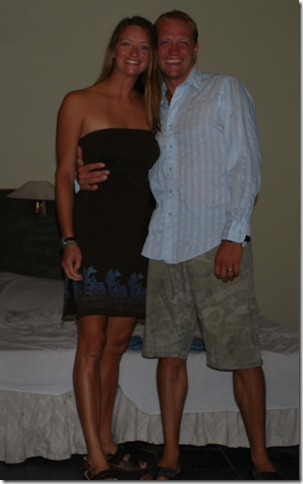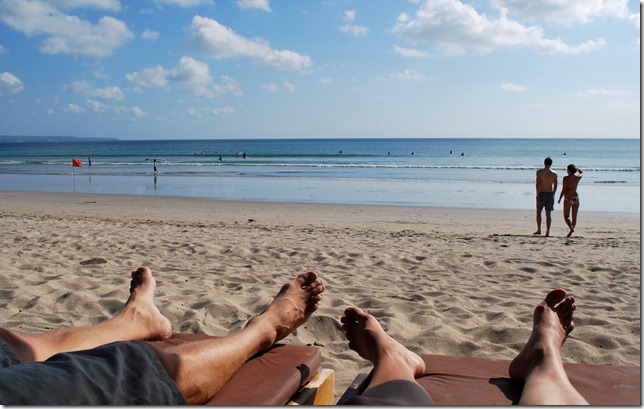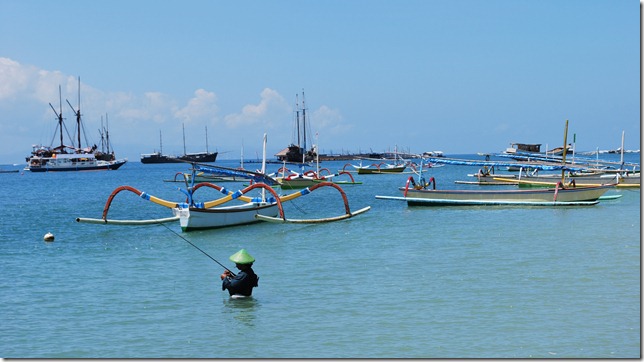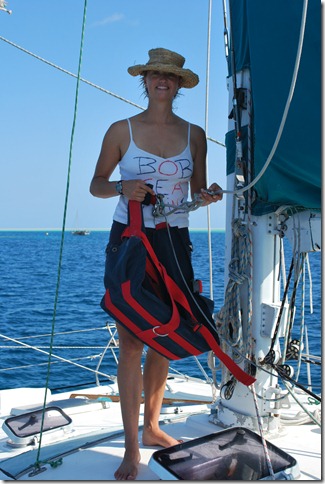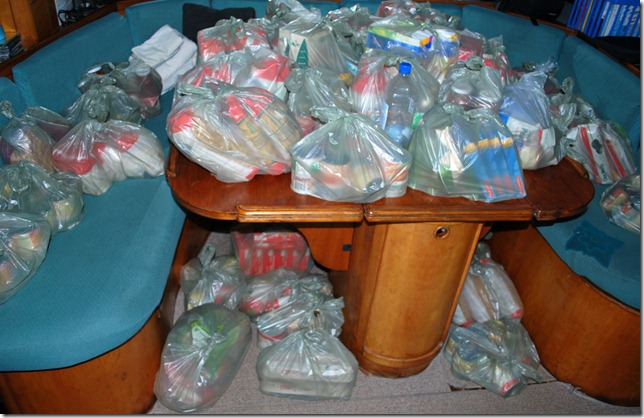Bali is nothing short of paradise for travelers on a tight budget. As Dallas put it, with a stack of $2 and $5 bills (actually 20,000 and 50,000 Rupiah notes), you can live like a king, and that’s what we’ve been doing. We are already talking about how hard it will be to leave here in a couple of years, I mean weeks.
Friday we walked around the village of Serangen and got a taste of local culture. The villagers were out and about on their scooters or walking, some of them wearing sarongs and the stereotypical Asian hats that look like a flattened cone. Most everyone was friendly, although the children seem much more shy around us than those in the Pacific islands.
The Balinese architecture is pretty distinctive. Villagers live in family compounds consisting of several small buildings dedicated to particular activities (cooking, sleeping, praying), all of which are surrounded by a stone wall. Each village has at least one temple, or pura in Indonesian (the locals always tell us this when they hear the name of our boat), and in the evenings we can hear singing coming from the local temple. The compounds and the temple here in Serangen seem to be in pretty good shape, but we were surprised at the amount of trash littering the streets and alley ways — not just the bits and pieces lying around, but actual piles of smelly rubbish right there in the middle of their otherwise orderly village. Perhaps there are trash services coming later in the week…
About every block or so there is a warung, a small building where food and various goods are sold, and we stopped in one yesterday for our cheapest meal so far — two bowls of mi goreng (ramen noodles with vegetables and egg) plus a glass bottle of Sprite for a whopping $2. Not necessarily gourmet, but it was tasty. Dallas and I are both suckers for a good deal, so I’m sure we’ll be back.
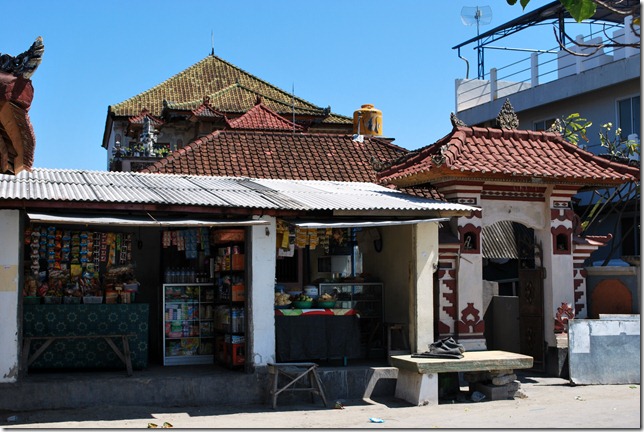 Warung with family compound behind
Warung with family compound behind
After lunch we headed back to the boat and packed a bag for an overnight stay in the beachside town of Kuta. We asked one of the local boys that provides services for yachties for a ride ashore so that we could leave the dinghy at the boat rather than on the dinghy dock. Crime doesn’t seem to be a major issue here, but we have learned from experience (i.e., Las Perlas Islands) that you can’t be too careful when it comes to the dinghy.
Kuta is where most visitors to Bali make their base. There is a nice, long, fine-white-sand beach with decent swell for surfing, vibrant nightlife, and tons of restaurants, shops, massage parlors, etc. We splurged on a $30 air-conditioned bungalow for the night and sat down for $3 personal pizzas and $2 large Bintang beers in a great little open-air restaurant with couches full of surfers using the free wi-fi. Such a rough life! We then swam and lounged at the hotel pool for a bit before Dallas was ready to further explore the cheap culinary delights. This time he opted for Mexican (veggie burrito), but what he got was more like an egg roll wrapped up in a flour tortilla.
We had read in our travel guide that the nightlife doesn’t really get going until late, so we returned to the hotel for a nice, long nap to prepare….Dallas was enjoying his sleep quite a bit, but it’s not everyday that we are in Kuta, so I persuaded him to rise from the dead and hit the town with me at midnight! He found it was worth the effort, though. We heard some great live music (hearing American classic rock sung with an Indonesian accent is pretty amusing), ate some more pizza, met some cool Frenchies, and did a lot of people-watching. Oh, and of course I got some dancing in while Dallas chilled on the nearest couch.
Ready for a night on the town
Sleeping in is not a skill that we seem to possess anymore, but we gave it our best shot and took it easy the following day. I got a much-needed haircut and pedicure for less than $5 and joined Dallas for some more lounging beside the pool. Then it was time to eat again and lounge some more — this time at the beach. If we don’t start trying to surf pretty soon, we’re going to be too out of shape to even attempt it! So far we haven’t followed our Bali itinerary much at all, but we are taking full advantage of the opportunity to relax and will set off to see the sights that we are most interested in a couple of days.
Getting in some serious R & R
HAPPY BIRTHDAY, DAD!!!!
For a sailor, one’s first impression of a country is a bit different than for the tourist that arrives via an international airport. The sailor’s first impressions include the sight of land from offshore when the hazy outline of the much anticipated landfall can barely be made out, the port officials and procedures, the first restaurant meal, the price of a cold beer, the shower situation, and of course, the flag. International conventions call for raising the yellow ‘Q’ (Quarantine) flag as well as the courtesy flag for the country being visited when the 12 nm limit is reached. Bali’s flag is unique in it’s simplicity: top half red, bottom half white. That’s it. It’s simple enough that if you didn’t know it was a country flag you could easily mistake it for one of the standard nautical signaling flags. I would say you could conclude from this that Bali isn’t a pretentious country, but we all know what adding a blue bar and turning things 90 degrees results in (France), so that’s probably a stretch (on a side note, we’ve really enjoyed the French people we’ve met on our trip).
As for the other initial impressions, I sighted land at sunrise when we were only about 20 miles from Bali. Southern Bali is low-lying and not yet visible, but I could clearly see the steep coast of the neighboring high island of Nusa Penida. The sight of land, however, was less impressive than the sea state. The good luck with tides that we’d enjoyed when approaching Darwin had abandoned us and we found ourselves fighting a strong tidal current that was running against the tradewinds. The result was steep seas and a course over ground (COG) that was about 120 degrees off of our heading. After changing sails and starting an engine, we got up to a whopping 1.8 knots in the right direction. We were shadowed in our approach to Bali by a local fishing boat that was returning to port. Even though they were 2-3 times our length, the colorful craft was only making about 3 knots. By the time things were done we’d taken different courses and lost sight of them, but as we entered the channel to Benoa harbor, we had to slow to let them pass and enter ahead of us. In the US, a boat this size would have outdistanced us easily, but here it was just crawling along.
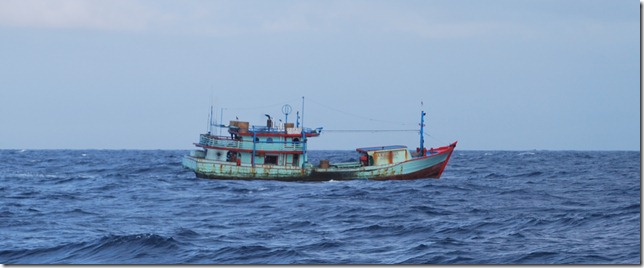 Finally a moderate sized vessel that’s no faster than we are
Finally a moderate sized vessel that’s no faster than we are
 Even this less popular beach was crawling with tourists
Even this less popular beach was crawling with tourists
The Bali International Marina is the smallest “marina” we’ve ever seen and there’s virtually no place to anchor, so we motored around for a bit before they finally found a spot we could tie up until 6am the next morning when we had to leave to make room for an arriving motor vessel. Oh well. It was an easy tie-up on an the outside edge of a dock that was nearly turned into a near-disaster by yours-truly. I had the boat pointed into the wind with the engines barely above idle to sort of keep us in place while we readied the docklines and fenders (we’d originally planned to anchor). When we were almost done, a large local ship was leaving a wharf about 100 feet away and started yelling at us to get out of the way. I’m not sure exactly what I was so preoccupied with (could have been the effects of getting up at 3am), but I forgot that the autopilot was engaged and started trying to up throttle and steer the boat away when I found that the steering wouldn’t budge – it was stuck and at the worst possible time. After signaling to the vessel that our steering was stuck, I finally maneuvered out of the way using the two engines and then started toward the dock using only the engines to steer. Within seconds of getting out of harms way I realized what was happening and turned the autopilot off. Definitely one of the dumbest things I’ve ever done in my life.
Clearing into Bali is a topic of much concern among cruisers for several reasons: (1) you have to have a $200 US cruising permit in hand before arriving that can take more than 4 weeks to get (we received ours in Cairns), (2) bribes (both as direct requests and also as fake fees/charges/fines) are not uncommon, and (3) there is an Indonesian law that has been on the books for a few years that requires yachts to pay a temporary bond of something like 30-40% of the boat’s value. Because this is Indonesia, the enforcement of that law is on a port-by-port, official-by-official, case-by-case basis. If you’re lucky, it’s no worries. If you’re not, it’s a huge bill for which the refund mechanism is anything but clear. You can pay $200-$300 to have a local “agent” sort it out for you and guarantee no problems, but that’s a bit of a rip-off in itself, so we did as usual and tried the clear-in on our own. As it turned out, we did just fine. Our first stop was immigration, where the officer was wearing a T-shirt and flip-flops. He later apologized for his attire (“I sorry, me no wear uniform today. Benoa too hot!”) He wanted us to pay $50 US and leave our passports, promising that he would bring them over to the marina later in the day with the our 30-day visas. This seemed a little odd, but he was an incredibly nice and relaxed guy and the price was in line with what Lauren had researched, so we went along and proceeded to the next office. We found everyone friendly and laid-back, especially after being greeted in their own language. It’s a general rule of mine to always greet officials in their own language when checking in and it almost never fails to make them smile and start things off with a friendly air. The local language is a little difficult because each greeting is only used for a few hours during the day (e.g., selamat siang from 12pm-2pm), but it worked out well. I did begin to doubt we could get the job done in the few afternoon hours we had left after immigration stamped each of the 5 copies of our crew list with 4 different stamps and then had to hand-write details into the blank field from several of the stamps. In the end, the crew lists that we kept ended up with 10 official stamps from a total of 5 different offices (harbormaster, immigration, customs, quarantine, and navy). The total charge was $2 US at quarantine and no requests for bribes.
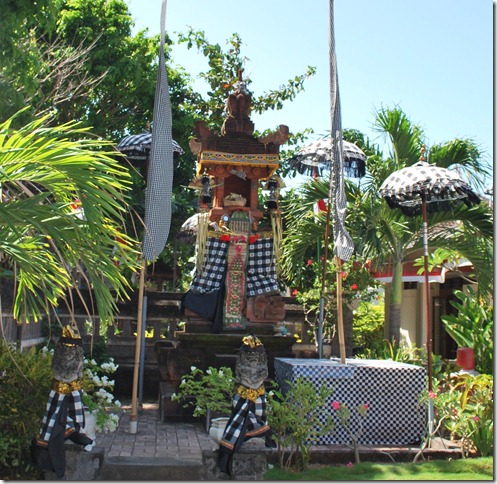 Shrines like this are everywhere, including on the grounds of government buildings
Shrines like this are everywhere, including on the grounds of government buildings
After failing to find a good spot to anchor, we’ve moved to a nice place that Kirk on S/V Salsa told us all about on the radio called Serangan. It’s relatively quiet (Bali Marina has fog horns blasting at 4am when local ships leave the wharf) and the people are really nice. We’ve been eating out twice already as meals are $2-$5 at the expensive marina restaurant and drinks are cheap as well. Somehow it seems that we always spend more in the cheaper places, but it’s nice to be having great restaurant food at such cheap prices. We enjoyed our first night of sleep even if we did have to get up at 6am, and soon we should be relaxed and recharged enough to venture farther into Bali.
Lat: 9 30.736′ S
Long: 116 52.510’E
Well, there’s not a lot to report, but we are making good time. Overall, this has probably been our most comfortable passage ever, which is pretty amazing considering the distance we’ve covered (865 nm so far). Yesterday we finally had to take the spinnaker down when we had lighter winds on the beam for a while, but by morning the wind had picked up again and was coming from the port quarter. We put up the smaller spinnaker and are making 6 knots again with a nice, easy motion.
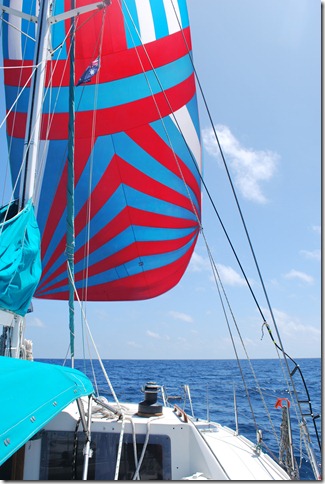 No complaints after several days of this…
No complaints after several days of this…
We’ve been using our time recently to plan a Bali itinerary (there’s enough to do that we have to remember to take time to relax…) and to look over possible routes and anchorages once we reach Madagascar, which seems like a fascinating place. It’s easy to see how so many people spend 5-10 years sailing around the world instead of the 2 we planned on.
The weather is great again today and we only have about 100 nm left to go, so we’re hoping to make landfall in the morning and complete our check-in in time for dinner on the beach.
Lat: 11 15.043′ S
Long: 120 37.122′ E
Getting to Ashmore involved just what the locals and cruising guides predicted: lots of motoring. We ran the engine about 90% of the way from Darwin to Ashmore, a ridiculous amount of motoring for us. Most of the time we could have sailed if we wanted to, but would only have been making 2-2.5 knots, which makes the 450 nm trip much longer than we were hoping. With the light winds came calm seas, so the passage was pretty comfortable and we were even able to get a few boat projects done. I’m really hoping to spend as much time as possible in Bali enjoying the place instead of doing boat work. We’re currently planning a 2 week stay, which would give us enough time to get off the boat and tour the island a bit.
The daily fly-overs and radio contacts with Australian Customs have continued. These guys are really something else. They’re friendly enough, but I can’t imagine the fuel bills for patrolling the Timor Sea. Speaking of seas, we’re still west of the Indian Ocean proper, so we’ve been passing though all sorts of straits and seas and gulfs. After spending over a year in the Pacific Ocean, we’ve now crossed the Coral Sea, Torres Strait, Endeavor Strait, Gulf of Carpenteria, Dundas Strait, Van Demien Gulf, Clarence Strait, Beagle Gulf, Timor Sea, etc. in a couple of months. It will be nice to be in the broad expanses of an ocean again where it’s simple to remember where you’re at.
Ashmore Reef has a few small sandy islands, but is mostly shallow reef and lagoons. It’s almost halfway between Darwin and Bali and not far off the rhumb line, so it makes a nice place to break up the trip. It’s a strictly managed marine reserve, and most of it is off-limits to the public, but there are some moorings. There’s also the Australian ship the Ashmore Guardian stationed there to monitor things and while we were there, a second larger Australian customs ship, the Triton, was cruising back and forth outside the entrance to the lagoon. As it’s only 100 nm from Timor, Ashmore is apparently a popular destination for refugee boats.
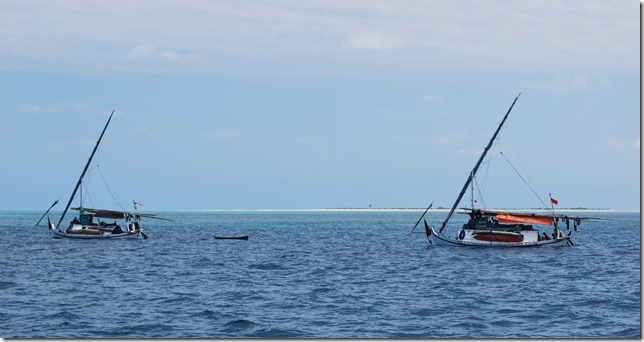 Indonesian fishing boats anchored at the pass into the main lagoon
Indonesian fishing boats anchored at the pass into the main lagoon
We made it to Ashmore with plenty of sunlight left and passed several traditional Indonesian vessels as we motored into the lagoon. They’ve been coming to Ashmore for hundreds of years and are still allowed to stop there to rest and to collect sea cucumbers and trochus shells. The wooden sailboats with dugout canoes as tenders and lateen rigs that are thousands of years old were really a sight to see. As soon as we moored in the inner lagoon and had a cold drink (running the engine gives us enough juice for the freezer), I took Lauren up the mast to have a look around and take some pictures. It was only her second time to go up and it was really a great spot, with beautiful lagoon views. Within seconds of being at the top of the mast, she spied a large sea turtle off to port and then later spotted a group of 8-9 spotted eagle rays swimming off to port as well. One of the Indonesian fishing boats moored next to us set sail and we yelled back and forth to them (Lauren yelling from above) as they passed in front of us. As they came directly upwind, I could catch the smell of a cooking fire burning aboard and see that the man at the helm was working a large wooden tiller, very similar to the one on the traditional Polynesian craft that we’d seen last year in Aitutaki. It was really something to see the ancient technology still being used to make a living today.
Lauren getting ready to go up the stick 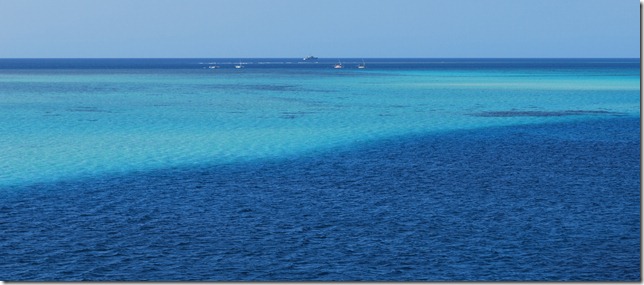
A view back toward the pass with the customs boat Ashmore Guardian moored in the background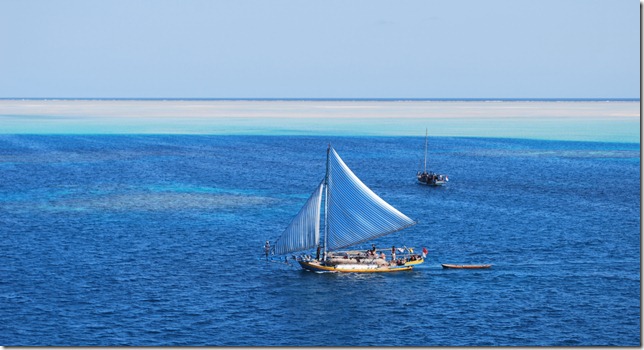
Traditional fishing boat. Check out the guy on the bowsprit to spot coral heads. 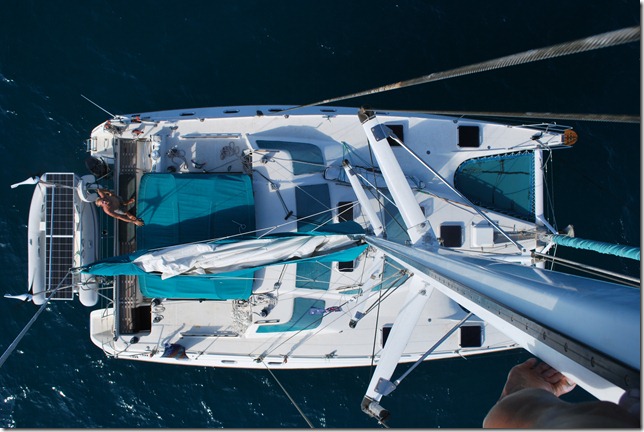 The old girl looks pretty good from a distance…
The old girl looks pretty good from a distance…
It’s been weeks since we’ve been able to get in the water, because to swim in northern Australia is to risk being dragged under by a large croc and never seen again. It felt so good to jump in during the hot afternoon and be floating in the cool water. We were told by the customs boat that scuba diving without a permit wasn’t allowed, so we donned our snorkeling gear and headed for the nearest large coral head. The snorkeling was pretty impressive, and I’m sure we weren’t in the best part of the reef. We swam in a triangle, first to a large coral head off to port, then to a head out in front of the boat, and finally back to the boat. By the time we’d left the second head, we must have seen 5-7 sea turtles of at least two different species, including a pretty large one (about a 4-foot shell). Except for one that was swimming near us, they were all resting on the bottom among seaweed and coral that they seemed to blend in with. It appeared they were just hanging out on the bottom taking a nap. We soon figured out that they were easily spooked (just pointing at one and swimming towards him caused him to speed away) but that their behavior changed if we were calm and just floated above them. Initially they got a little uncomfortable and left their place on the bottom to swim away, but when we just stayed put and floated, they would get curious and actually swim toward us to check us out before heading back toward the bottom.
We saw plenty of beautiful fish (our 2nd underwater cam is on the Fritz, so no pics) including a strange brown and black camouflaged nurse shark of some sort as well as lots of rays with blue spots and tails on the bottom, but our best experience came as we swam back toward the boat. Although the water was beautiful, the visibility wasn’t that great — only 35-40 feet or so when looking down, so we were surprised when we saw a group of large spotted eagle rays swimming across our path from left to right. There were 8 of them swimming in formation with their wings slowly pushing them along. Although they had to be aware of us being there, they just kept on swimming ahead of us for a minute or two, although the one closest to us did circle back a bit to have a better look at us before re-entering the formation. Unlike stingrays, which are usually fairly flat, the spotted eagle rays have a relatively thick mid section and features that come closer to resembling a face. The way they move through the water so gracefully really looks more like flying in slow motion than swimming. It was only the second time we’d seen a spotted eagle ray and to see them all swimming together was definitely one of the coolest things we’ve seen underwater.
Between all the snorkeling and being at sea for several days, it was all we could do to stay up till 9pm, so we went to be early, tired but pretty happy with our current way of life. The next morning we were just starting to get around when a couple of Indonesian fisherman from one of the boats anchored in the pass showed up at our stern in a dugout canoe. The only English they knew was "mister" and "thank-you", and the words and phrases in the Lonely Planet Bali book were great for going to a restaurant or booking a hotel, but they weren’t too great for a chance meeting at sea. In the end, we concluded that one was Hindu and the other Muslim and both were from Bali. We ended up giving them a pair of old fins that needed a repair, a few small pieces of spare line, cups of coffee, and some cold water for the trip back to their boat. They were pretty happy just to hang out and were fascinated by the phrase & translation portion of the Lonely Planet book, but eventually it was time for us to eat breakfast and get ready to go.
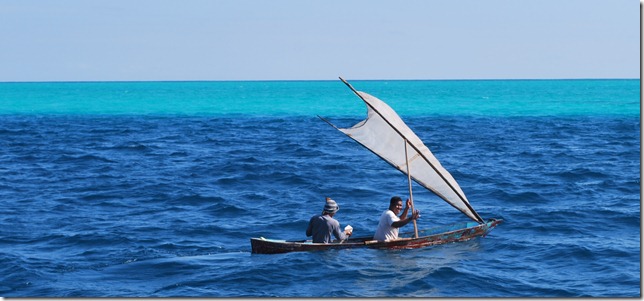 Indonesian fisherman sailing & bailing the dugout canoe. The sail rig is roughly a 2000 year old design.
Indonesian fisherman sailing & bailing the dugout canoe. The sail rig is roughly a 2000 year old design.
We wanted to try to make Bali by Friday to check in before the weekend, and so far it looks like we’ll have no problem. Just as predicted, we started getting good winds just as we got to Ashmore and we’ve had the spinnaker up ever since leaving. At this rate we’ll be in Bali Thursday morning. In addition to picking up good wind, we’re back in deep water again (1000’s of feet). From the Torres Strait to Ashmore, we’ve seldom been in more than 300-400 feet of water and much of the time we’ve been in 200 feet or less. That’s a big change compared to the open ocean and it’s made a big difference in how far out at sea we can be and still feel the currents associated with the tides. Hopefully the steady breeze and calm seas continue. The warm, clear days and starry nights are nice, although a break from the midday heat would be nice, too. We hit 90 degrees in the salon today and there isn’t much of a breeze when we’re sailing downwind like we are now. Oh well, I suppose the heat of the tropical winter still beats August weather back home.
Lat: 12 18.397′ S
Long: 126 21.726′ E
It is day three of our passage to Bali in very light winds. We’ve been using the motor on and off and still only averaging about 100 miles/day, but in such calm seas, we are able to function on the boat as if we were at anchor (except for the sleep deprivation bit). We are now only 200 miles from Ashmore Reef and looking forward to stopping to sleep and to check out the Australian-operated marine reserve there.
Our last days in Darwin were busy and fruitful. Woolworths delivered our bags and bags of groceries right to the boat ramp, and we were able to load them into the dinghy and get them onto the boat in one trip. It really could not have been any easier. However, between catching up with our friends on S/V Marionette who had just arrived, selecting a couple of Aboriginal paintings, going to the Aboriginal documentary, getting duty-free diesel from the wharf on the other side of town, and clearing out with customs, we didn’t have time to stow the groceries until the following day (Tuesday) when we were underway. Normally we wouldn’t have weighed anchor and set sail for another country with bags and jugs strewn all over the boat, but we knew that we would be motoring in light winds with plenty of time to get organized.
Darwin was definitely the place to pick up Aboriginal artwork. There are galleries on each corner of the city center, and we had fun perusing them and trying to decide on a couple of pieces. We ended up bypassing a large one that had the "wow factor" but would probably lose its luster after a while (like a shallow supermodel) and opted instead for a slightly smaller and more subtle but very interesting painting patterned after a lizard’s skin as well as a smaller, more traditional painting representing a mother and child. In general, the quality and unique style of the paintings that come from the tribes of the Northern Territory is extremely impressive, so much so that I am interested in importing several pieces to sell in the U.S. at some point.
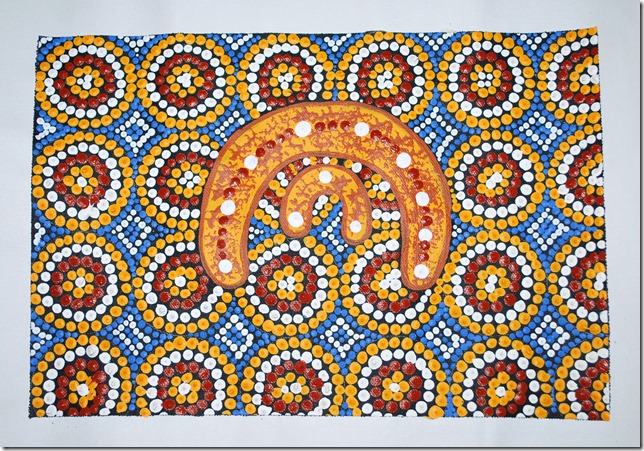 “Manjala” (New Born Baby Song) by Bummalibina (“Penelope”) Green
“Manjala” (New Born Baby Song) by Bummalibina (“Penelope”) Green
The documentary entitled "Our Generation" was screened at the Deckchair Cinema, a really nice outdoor theater next to the city park. It was a full house of mostly "non-indigenous Australians" (white folks) as well as some indigenous peoples from the Northern Territory (NT) tribes. The documentary was created by a white Aussie woman who had spent some time living with one of the tribes and was there when the white officials came in 2007 to investigate child abuse. It sounds like they went on a hunting expedition in all of the NT Aboriginal communities based on limited evidence of abuse, and in order to do so, had to suspend the Racial Discrimination Act. This is one of many governmental policies and practices that was denounced in the documentary. Some compelling information was presented such as the United Nation’s declaration of the Aussie government’s policies as racist. Also, the life expectancy of Aborigines is lower than that of any other Indigenous people in the world, due in large part to the many diseases that affect them in their over-crowded living conditions (up to 20 people living in a 3-bedroom house!).
In a nutshell, it seems that the oldest society in the world (30,000 years old according to carbon dating) was not only displaced by the newest society in the world but was then expected to assimilate, with very poor results. We left thinking that it would behoove the Australian government to expend their funds, efforts, etc. in ways that better fit the Aboriginal customs and beliefs instead of imposing upon them a lifestyle of Western-style poverty and a feeling of indignity.
OK, I’m off my soapbox now. There’s not much else to report. We are just getting spoiled by having so much peace and quiet with just the two of us on board. The boat is in good shape except that the roller furling for the jib is "getting stuck" (my version of a technical description). Dallas is not happy about this after just paying hundreds of dollars to have the bearings replaced in NZ. Hopefully sorting this out won’t occupy too much of his time when we are in Bali, as we both can think of better things to do!


